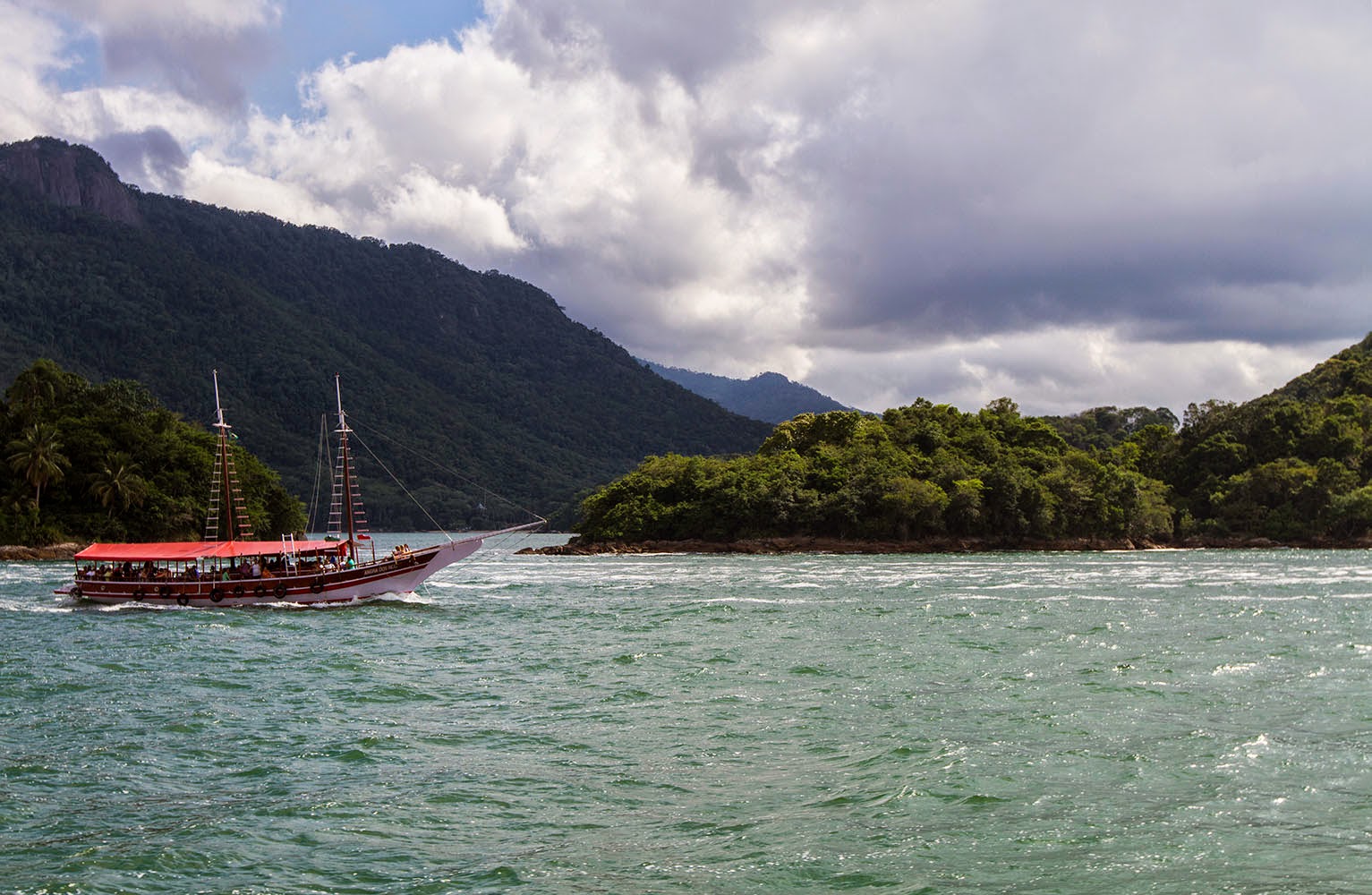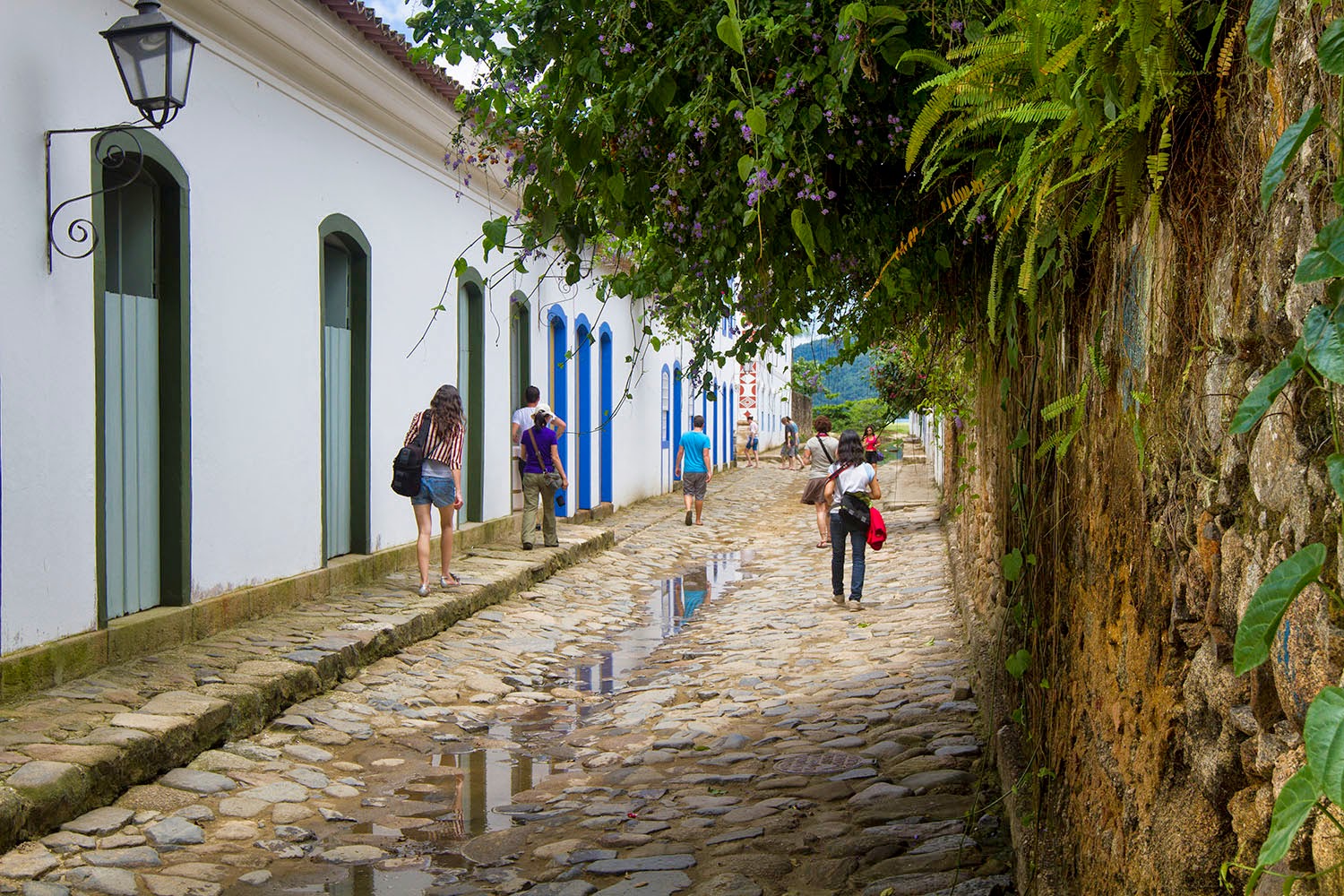 |
| Like a necklace on a bosom - the unparalleled topography of Rio de Janeiro |
Ah, Brazil.
Land of the Samba.
Brazil has been on my bucket list since I was a teenager. Like only a handful of other countries (Egypt and France being the other prime examples) it beckoned me with a particular draw, capturing my youthful imagination with vivid, colorful images of gyrating Carnival, expansive, voluptuous geography, and the sultry atmosphere of Rio de Janeiro.
Though my fascination had cooled a bit as I got older, Brazil never ceased to hold a special place in my heart, and it was with much anticipation that we embarked on this adventure over the winter holiday break.
Though we landed in Rio, we didn't stay long on our first brush with the city. After overnighting in a Copacabana area hotel, we boarded a bus and departed for Ilha Grande. Our guide did have time in the morning to turn us on to the transcendent deliciousness of açai bowls (açai berries blended with ice and honey, mixed with nuts and granola, and sold at just about every corner of the city) - so I scored 2 before hopping on the bus. In retrospect, that was a mistake, since the punishing high speed jostling that ensued as we left the city turned eating highly pigmented goop with a spoon into a feat of acrobat-level coordination.
It was a scenic coastal drive to the port town of Angra dos Reis, where we waited for our ferry to Ilha Grande. Since this was our first real glimpse of the country, we took the opportunity to walk around the town a little, unassuming as it is, and take in the characteristic hill-hugging neighborhoods.
 |
| Angra serves as a port to Ilha Grande, which is a resort island popular with Brazilians. |
 |
| the wavy tilework of the sidewalks is not exclusive to Rio. |
 |
| going up and down the narrow alleyways |
 |
| stacked living |
 |
| kids playing during recess outside a school building. |
The ferry ride itself is a breezy open air affair lasting about 40 minutes. We sailed past emerald green hills of small islands, turquoise lagoons and rocky shores, through a channel that looked pristine and prehistoric, save for a few luxury villas on some of the islands that could be spotted through the foliage.
 |
| Leaving the port behind |
 |
| Holiday makers. |
Formerly a maximum security prison, Ilha Grande was spared a lot the development of the 2nd half of the 20th century, and its unspoiled beauty began attracting crowds once the prison was shuttered. Rainforest has reclaimed most of its structure, but you can still see some walls and cells along the beaches. We settled into an adorable little lodge just a few blocks from the beach. There are no cars on the island, so wheelbarrow-wielding porters act as bell boys for your luggage. There are no highrise hotels or big themed attractions either. No banks or ATMs (bring cash!), no cell service and only the most rudimentary spotty wifi. The idea is to step off the boat, relax, and let go for the duration. What the island does have is plenty of guest houses, lodges, quaint little restaurants, and a myriad of small businesses ready to cater to your every water-related desire.
 |
| view from our cabin, over the very handy hammock. |
 |
| Not bad for a prison :) |
 |
| taking a little walk around the area to acquaint ourselves with the surroundings. |
 |
| miles of deserted beaches |
 |
| A little beachfront dinner action at Cafe do Mar. We shared a wonderful seafood paella for 2 here while a musician strummed his guitar to some Latin tunes. |
Since Ilha Grange is quite hilly and covered in rainforest, it does offer some great hiking opportunities. We joined a group of other visitors to take a guided rainforest/beach hike. Though humidity, heat and bugs should be considered, and it IS a rather strenuous up-and-down trek, it offers some amazing panoramic views from the crest of the hills and a chance to get up close and personal with a lush rainforest ecosystem.
 |
| Warning - Brazilian trails don't zig-zag, they just go straight up! |
 |
| it's a jungle out there! |
 |
| great views from the top |
 |
| These little funky-monkeys are everywhere on the island, and are quite fearless. This one posed for his close up for a good 5 minutes and was very upset that he didn't get a treat. |
Ilha Grande is a protected area. The biodiversity here is some of the highest in Brazil, in plants, marine and land animals. One of the reasons the island remains so undeveloped is to maintain it in this undisturbed and ecologically thriving condition.
 |
| how about some bodyboarding?? |
 |
| one of the beaches we visited on our hike. |
 |
| Another beach. Aside from our group, we barely saw a soul. All of these glorious beaches, completely deserted. |
 |
| A path leading from the trail, through the mangroves, to the third and final beach of our hike - Lopes Mendes. |
 |
| Lopes Mendes - considered one of the most beautiful in the world, and certainly the most beautiful in Iha Grande. |
It was definitely a lovely beach - huge, clean, with flour-fine white sand and with sweeping views in every direction. But - I'm not a big beach person, so to me a beach is just a beach. Once I've had a chance to swim and dry off, I'm ready to move on. So, we left the beach bums to their devices, and went back to the bay to do some canoeing.
Ilha Grande is a great destination if you're looking for a place where you'll be forced to unplug and unwind. It's a popular place for scuba and snorkeling, fishing and hiking, and lounging on a fine beach with a caipirinha. Its primitive quiet is wrapped in a million shades of green and sounds of trees, waves, and wildlife. It's the perfect escape.
Paraty
Our next stop after Ilha Grande was Paraty (pronounced Pa-ha-CHEE). This was a colonial town established by the Portuguese in the 1600s as a port city for transporting gold from the mines of Minas Gerais state to Portugal. The city saw its heyday during the gold rush, when a 1200km road connected it to the mines, and brought in other goods and services to keep the area thriving. It was, however, plagued by pirates, both on land and at sea, where pirates constantly attacked the gold-laden ships bound for Portugal. When the mines ran out in the 1800s the town quickly declines, and in fact was all but abandoned, until production of cachaça (liquor used to make caipirinhas - a traditional Brazilian drink) brought about a revival in the 19th century. Today the town is primarily a bucolic tourist stop, still known as much for its cachaça as it is for its lovely, cobblestone streets and brightly colored doorways.
 |
| All the buildings are whitewashed stucco, only the doors and windows can be different colors. |
 |
| the cobblestone streets of the old town. |
 |
| Rua do Fogo - Street of Fire (former red light district) |
 |
| A view towards the bay of Paraty |
The streets of the old town flood every day with the tide. Originally, this was used as a sanitation method to clean the streets in a time when people chucked garbage and sewage directly from their windows to splash on the street (and unsuspecting bystanders) below. The tidewaters would sweep in and recede, taking the unpleasantness with them. Today of course people don't throw poop from their windows, but the moon still pulls at the ocean so - there you go. The photo above was taken as the tide was coming in - you can actually watch the water creep in, inch by inch, from the bay!
 |
| the beautiful Paraty Bay |
 |
| we rented bikes and pedaled around town, including a few beach stops for a boozy break. |
 |
| One thing I love about Latin America - they know how to juice. The fresh squeezed everything is such a delight, especially with a shot of tequila in it. |
 |
| All of Paraty's streets are curved as a safety measure against invading pirates. They could never get a clear shot or line of sight that way. |
 |
| Our Posada, or guesthouse. |
 |
| Add caption |
One of the more popular things to do in the area is to take a sailing tour of the bay. A large schooner takes you around the scenic bay and stops at several secluded beaches for a swimming/snorkeling break.
In all, it's a great way to spend the day - sun, sand, sea, drinks, floaties - what more could you want? The only thing that bugged us throughout was how crowded the ships are that do these tours. We had this excursion pre-arranged through our tour so we didn't have much choice in the provider, but I would recommend asking around and going with smaller companies operating smaller vessels that might charge more, but not pack you in like sardines. Having 11 inches of sticky wet butt space on a bench between beaches was not a great experience. I snuck out onto the hammock on the bow whenever I got a chance, but they eventually caught on and told me to get down.





























































































































